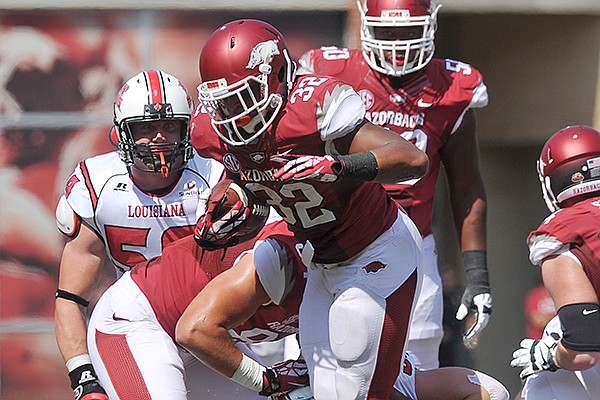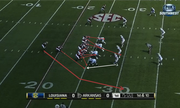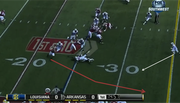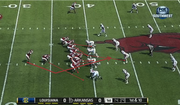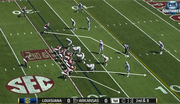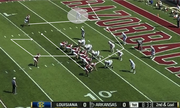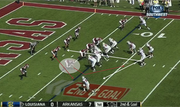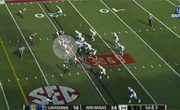FAYETTEVILLE — A win over a Sun Belt school is not normally a cause for celebration, but the complete 180-degree change from the program that Hog fans endured in 2012 was a welcome sight. A disciplined, focused, confident team overpowered a strong mid-major by dominating them in the trenches and reducing their offense from a high-powered Spread to a one-man show.
Arkansas is 1-0 - the record Bret Bielema has targeted all offseason.
In this review, we’ll start by examining the predictions made in the article published Friday. Then we’ll name an offensive and defensive MVP, and then we’ll go through some film review.
Prediction #1: Arkansas will get a solid game from Brandon Allen
Quarterback was a concern for many entering this one, but I was not among those. Against Florida and Alabama, it may be a different story, but against a team with a weak pass-rush who was looking to stack the box against the run, I had full confidence that Allen would shred the Cajuns. He was a four-star recruit for a reason, and a disastrous 2012 should not have shaken anyone’s confidence in his abilities. He has a stronger arm than Tyler Wilson, and is more mobile than either Wilson or Ryan Mallett.
Allen completed 15 of 22 passes for 230 yards and three touchdowns, with zero turnovers and only one sack. He showed excellent mobility and vision on his first touchdown to Herndon, and then flashed his arm strength on the 49-yard bomb to Herndon. Allen, who did not throw an interception during his senior year of high school and hasn’t thrown a pick in a scrimmage since Bielema was hired, didn’t have a single pass that could have possibly been picked off.
I made this prediction thinking that ULL would stack the box, and that Allen may be required to hit some passes to keep their defense honest, but in actuality the Hogs ran the ball a little better than I expected, so most of Allen’s passes were in order to achieve offensive balance and keep the defense on their toes, rather than make necessary conversions. I get the feeling that Jim Chaney did not tip his hand as to complex and powerful the Hog passing game can be, and probably won’t until the Rutgers game.
Prediction #2: Louisiana-Lafayette will show us why Terrance Broadway is such a dangerous playmaker
Broadway showed a multitude of abilities on the Cajuns’ first two drives, executing a draw, a couple of read options, and some short passes. He threw for just under 200 yards with a touchdown and an interception. He gained about 20 yards rushing, but sacks brought his final tally to -1 yards on 13 carries, a career low. He averaged nearly 100 rushing yards per game last year. More on this below.
Prediction #3: Arkansas will generate a sustained pass-rush
Trey Flowers recorded two sacks, and that’s not counting his forced fumble: apparently, if a strip-sack fumble goes forward, it does not count as a sack. Don’t ask why, but if it did count, Flowers would lead the NCAA as the lone man with three sacks (a Buffalo linebacker had 2.5 on Saturday). As it stands, the Hogs recorded four sacks, one strip, and a tipped pass that was intercepted by Jamichael Winston. The Hog defensive line was monstrous as expected, eventually taking away the read option and inside running game. The Cajuns finished with 85 yards rushing, but 35 of them—almost half—came on their first two drives.
Prediction #4: Louisiana-Lafayette will win their share of battles in the inside run game, but Arkansas will eventually take that away, reducing ULL to a one-man show
As expected, the Hog defensive ends, especially Trey Flowers, closed on the read option. Just like in their game against Florida in 2012, the Cajuns abandoned that approach early on (after their first touchdown). I also noted in the preview (to the frustration of ULL fans who posted my preview on their message boards) that Broadway was not very good at the deep ball, but despite their criticism the game proved me right on that case. I only saw one completion in which the ball traveled more than 10 yards past the line of scrimmage. Broadway badly misfired on a couple of midrange passes in the first half, and Coach Ash’s second-half adjustments included moving our cornerbacks even closer to Cajun receivers, which led to more sacks and more incompletions as Broadway was unable to threaten with the deep ball. The “one-man show” took form in the third quarter, when ULL’s run game and deep passing game was gone, and the only offense the Cajuns could muster was a series of short passes.
MVPs of the Game
Offensive co-MVPs: Travis Swanson and Kiero Small
Plenty to chose from, but the captains stole the show. While conference rival Texas A&M deals with a leadership crisis, Arkansas’ captains backed up their confidence with blue-collar performances. Swanson was brilliant on pull plays, showing an excellent mix of strength and mobility, and Small absolutely flattened ULL’s linebackers to pave the way to 292 rush yards, the Hogs’ highest total since 2010.
Other notables include Allen (15/22, 230 yards, 3 TD), Jonathan Williams (18 rush, 151 yards, TD), Alex Collins (21 rush, 131 yards), Hunter Henry (5 catches, 75 yards), and Javontee Herndon (3 catches, 73 yards, 2 TD).
Defensive MVP: Trey Flowers
Flowers is the easy choice. The junior collected two sacks and a forced fumble, and helped convince ULL head coach Mark Hudspeth that the read option was probably a bad idea by confusing Broadway into keeping the ball and then dropping him for a two-yard loss on the Cajuns’ opening drive, which led to a missed field goal.
Other candidates include Will Hines, who dropped two interceptions but put himself in good position most of the game, including swatting away a potential touchdown on third down on ULL’s opening drive; Jarrett Lake, who was the best linebacker on the field for the Hogs; and Jamichael Winston, who showed good pass-rushing abilities and intercepted a pass.
Film Review
It’s time for everyone’s favorite part: the film breakdown. Let’s start from the very beginning, shall we?
Here’s the first play of the Bret Bielema era. It’s an off-tackle run over the right side, and was featured heavily on Saturday. The two key blocks belong to Travis Swanson and Kiero Small (there’s a reason they are the offensive MVPs). On the right, Brey Cook takes the defensive tackle and Grady Ollison takes the end. Swanson pulls to his right and “kicks” out the defender in the B-gap.
Notice the block of Kiero Small, who has taken out the linebacker. Small is the lead blocker who runs off-tackle to the right and takes out the first defender; in this case it was the outside linebacker (his path is in white). Williams goes outside of all of this and is finally run out by the safety after a 13-yard gain.
On the second play from scrimmage, the Hogs replace the twin receiver (Horton) with an extra tight end on the left side (Henry), and then call the same play. This time, however, it becomes apparent that this play is an option for the back called a lead. Swanson and Small are leading for two different options. On the first play, Williams followed Small’s block outside for a 13-yard gain. On the second play, Williams elected to cut inside behind Swanson, and picked up 14 yards.
Expect this lead play to be featured in the Hog offense. Against most defenses, Williams will decide to go inside, but when defenses start stacking the box, Williams can follow Small outside. You may watch and think that the Hog offense has made “adjustments,” but the reality is that they have called the same play.
For those wanting to conceptualize the lead play, here it is.
Now I know you’ve heard the phrase “a good running game opens up the play-action pass.” Well, the lead play opens up a good play action fake of the lead and a short pass.
Small runs out to his right, like he’s blocking for the lead. The linebacker, who is responsible for defending the flat AND for defending a run through that D-gap (where the fullback is blocking), thinks it’s a lead play and comes down to stop it. However, Small runs right past him and out to flat. Williams blocks him instead, and the flat is left undefended. Allen carries out his fake, and tosses it out to Small in the flat. Arkansas’ third touchdown of the game came on this pass, and I saw it run at least three times. A good running play usually has a complementary play action that allows a team to open up the passing game.
Let’s move back to the to Brandon Allen’s first pass attempt (and completion) as the full-time field general for the Razorbacks.
It’s 2nd-and-8 after Williams rushed for two yards. To this point the Razorbacks have been using an unbalanced formation. Note that an unbalanced formation is different from an unbalanced line. The offense is required to have seven men on the line of scrimmage. Typically these are five linemen and two eligible receivers (either split ends, tight ends, or one of each). In a balanced formation, there is one end on each side. However, Arkansas goes with an unbalanced formation where all ends are on one side (see above diagrams).
On this play, Kiero Small gets a much-deserved break, and the Hogs have two receivers and two tight ends, all on the left side. The Hogs motion Hunter Henry and Jeremy Sprinkle across to the right to balance the formation, and then Henry runs a decoy route to draw the cornerback off. Flanker Julian Horton comes across the field to draw the safeties’ attention. Jeremy Sprinkle is then open in the flat for an easy completion and a five-yard gain.
Now let’s look at the touchdown.
Horton is lined up on the wing (outside the tight end, off the line of scrimmage), and Javontee Herndon and Hunter Henry are the receiver/tight end combo on the left side. At the snap, Allen fakes the handoff to Williams and rolls to his left. To complete the play-action, Horton comes charging across to the left and blocks the defensive end, who could otherwise rush Allen. It appears that only Loewen (right tight end) and Herndon are running routes on this play. Neither are open, so Allen takes off. However, he exhibits excellent vision while he scrambles: as the ULL defensive backs charge him, Herndon sneaks to the back corner of the endzone, and Allen finds him for an easy touchdown.
Now let’s examine why Trey Flowers is Defensive MVP. Louisiana-Lafayette prided itself on being a read option team, but things didn’t work as planned in the option game, thanks in large part to Flowers.
In the Preview, we examined the scrape exchange as a way to stop the read option. The Hogs used it on Saturday, and Broadway was held to -1 yards rushing. Four sacks helped, but Broadway collected under 30 yards going forward… a step down from the nearly 100 yards per game he was averaging.
Here, the Cajuns are running a variant of the read option commonly referred to as the inverted veer. Chris Brown of smartfootball.com gave the name to the play when it was first used at TCU under Gary Patterson (Justin Fuente, now Memphis’ head coach, was the offensive coordinator) circa 2006, and it has since stuck. In an inverted veer, the quarterback has a read between the back going outside, and himself going inside (as opposed to the back going inside, and the quarterback going outside). Arkansas uses a scrape exchange to stop it. Linebacker Jarrett Lake is responsible for the “outside man” (back) while Flowers is the read DE, responsible for the inside runner (Broadway). Flowers jukes to his right, forcing Broadway to keep it, and then drops him in his tracks for a loss. Athletic defensive ends were one of the reasons why analysts believed the read option would not work in the NFL, and Flowers’ athleticism backed their claims up by taking out the option all by himself.
Now we move to the second half. The most electrifying play of the game came in the third quarter, when Jonathan Williams broke free on a 75-yard run to push the lead to 34-14 and seal the deal.
You may recognize it. It’s the same lead play that Arkansas began the game with, out of yet another formation. Small is in the offset I, and he takes out the defender over the right side. Williams decides to make the inside cut. The Hogs are again unbalanced in formation and have stacked a tight end, a wingback (Nate Holmes) and a wide receiver on the left side. Holmes does an excellent job of blocking the linebacker (actually, he tackled him), which freed Williams up to cut back to his left. Holmes got back to his feet and then ran about 50 yards alongside Williams, blocking his last pursuer (in the back…). That’s a good example of the speed the coaches have been talking about!
The final photo to look at is something that I’ve never seen Arkansas do on defense, although some of Nutt’s early defensive coordinators like Burns or Thompson may have used it. It’s called a “psycho front,” and it’s usually a third-down defense designed to confuse the offense as to where the pressure is coming from.
Here, the Hogs use two defensive ends and zero defensive tackles. Those three guys in the middle are all standing up like linebackers. It looks there are a couple of linebackers and maybe a backup defensive end out there. At the snap, some will drop into coverage, and some will blitz, and the offensive line has no idea who. In this particular play, all three blitzed, and Chris Smith got through the tackle and made the sack of Broadway.
I saw the psycho front twice, and both times the Hogs got a great pass-rush from it, including that sack. Expect to see that in the future.
I plan on saving some offensive breakdowns such as the end-around run with Nate Holmes until we run it more than once. We gave him to him once for a short gain, but before that we had faked it on a play-action pass; but Allen was sacked, the only sack of the game against the Hogs. If the Hogs unleash it in the next couple weeks I’ll diagram it.
The Preview of the Samford game should come out at the end of week, but be advised it won’t be near as extensive as the Louisiana-Lafayette preview, due mostly to the fact that it’s a weak FCS school that doesn’t really require any deep analysis, and the Hogs can probably name their score. In addition to this, finding film and some sabermetrics on an FCS team is going to be difficult, but we’ll make some predictions on how the offense and defense will develop nonetheless.

